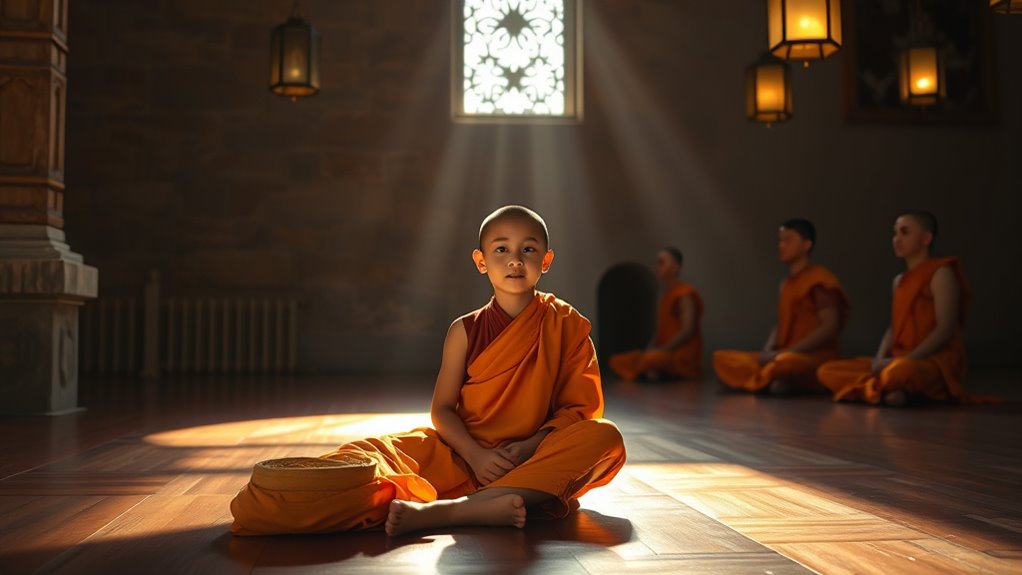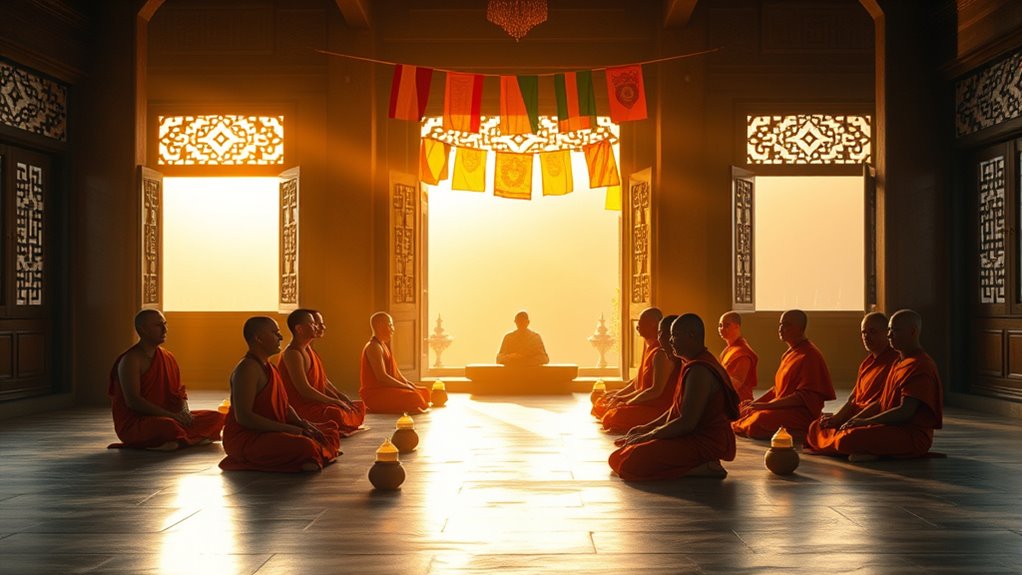Living with monks for a month immerses you in their disciplined daily routines, from early mornings with meditation to mindful work and meals. You participate in structured activities that promote focus, serenity, and inner growth, experiencing firsthand how routines foster calm and reflection. Meditation becomes a core part of your day, helping you manage stress and develop patience. If you continue, you’ll discover how these simple practices can transform your understanding of mindfulness and inner peace.
Key Takeaways
- Daily routines in monasteries are structured around meditation, work, and mindful activities, fostering discipline and spiritual growth.
- Meditation sessions are central, helping residents develop awareness, patience, and mental clarity.
- Meals are consumed in silence with gratitude, turning eating into a mindful, reflective practice.
- Routine chores are performed mindfully, transforming everyday tasks into opportunities for reflection.
- Leisure time includes reading Buddhist teachings, promoting deeper understanding and inner peace.

Have you ever wondered what it’s like to live alongside monks? Spending a month in a Buddhist monastery gives you a rare glimpse into their daily lives, where discipline and mindfulness shape every moment. One of the most striking aspects is the monastic routines that structure their days. From dawn until dusk, every activity is purposeful and scheduled, reinforcing a deep sense of order and spiritual focus. You’ll notice that mornings begin early, often with the sound of bells signaling the start of meditation. These routines aren’t just about tradition—they’re designed to cultivate discipline, clarity, and compassion. As you participate, you realize that each task, whether it’s sweeping the grounds or preparing meals, is a form of mindful practice.
Daily meditation is at the core of their routine and is something you quickly come to appreciate. It’s not just a brief period of quiet; it’s a cornerstone of their spiritual discipline. You might sit in the meditation hall alongside monks, observing how they settle into their postures and breathe deeply, focusing their minds inward. During these sessions, the world outside fades away, replaced by a profound sense of presence. You’re encouraged to follow their example, and soon, you find your own mind settling, distractions dissolving. Daily meditation isn’t about achieving a certain state but about cultivating awareness and equanimity. Over time, you discover that this practice helps you manage stress, develop patience, and gain insight into your own mind. Research supports that meditation enhances mental well-being, making it a valuable tool for personal growth.
Living with monks means embracing a routine that’s both simple and deeply meaningful. Meals are taken mindfully, often in silence, with an emphasis on gratitude for what sustains you. Work periods follow, where tasks are performed with attention and care, turning daily chores into meditative acts. Even leisure time is structured, often involving reading or listening to teachings, all aimed at fostering a deeper understanding of Buddhist principles. The consistency of these routines creates a rhythm that calms your mind, making space for reflection and growth. By immersing yourself in this way of life, you begin to see how monastic routines and daily meditation aren’t just practices—they’re pathways to inner peace and clarity that can transform the way you approach your everyday life.
Frequently Asked Questions
How Do Monks Earn a Living Outside the Monastery?
Outside the monastery, monks often earn a living through lay contributions and monastic careers. You might find them teaching, offering spiritual guidance, or engaging in community service. Many rely on donations from laypeople, which support their livelihood. Some take on jobs like writing, translating, or running small businesses. These activities help sustain their spiritual practice while contributing to the community, balancing monastic discipline with practical needs.
What Are the Daily Routines of Monks Beyond Meditation?
Imagine stepping into a well-oiled clock, where each gear turns seamlessly. Beyond meditation, your day begins with donning simple monk attire, symbolizing humility. You tend to daily chores—sweeping courtyards, preparing meals, and maintaining the temple—like the steady hands of a craftsman. These routines keep the monastery alive, fostering discipline and mindfulness, just as each cog keeps the clock ticking smoothly, embodying harmony and purpose in every task.
Do Monks Have Personal Relationships or Families?
You might wonder if monks have personal relationships or families. Generally, they choose monastic solitude, dedicating their lives to spiritual focus and practice. Most monks take vows of celibacy, which means they refrain from romantic relationships and familial ties to deepen their spiritual journey. This commitment helps them maintain inner peace and concentration on their spiritual goals, emphasizing discipline, mindfulness, and devotion rather than personal attachments.
How Do Monasteries Handle Visitors or Volunteers?
When you visit a monastery, think of it as opening a door to serenity. They warmly welcome guests with a simple, respectful guest reception, often offering guided tours or meditation sessions. Volunteers usually take on roles like assisting with chores, teaching classes, or helping in community projects. Monasteries value your presence as a chance to share their way of life, but they also set boundaries to keep the peaceful environment intact.
What Challenges Do Monks Face in Modern Society?
You might notice that monks face challenges balancing their spiritual duties with modern life. They need to foster layperson engagement while maintaining tradition, which can be tough. Technological adaptation is essential; some monks embrace social media or digital tools to connect and share teachings, but they also struggle to avoid distractions. Finding harmony between ancient practices and contemporary society requires effort, patience, and a genuine desire to serve both their community and spiritual growth.
Conclusion
Living with monks shows you that simplicity is the true luxury, like finding a quiet oasis in a busy desert. You learn that discipline and mindfulness aren’t just words—they’re the rhythm of daily life. As you leave, you carry a little of their serenity with you, like a gentle breeze that stays long after the wind has passed. This month becomes a quiet symphony, reminding you that peace is often found in the stillness.








